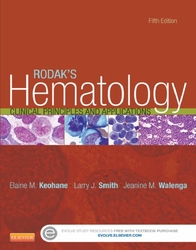「重要なお知らせ:日本語書籍をご購入いただき、eLibraryをご利用の皆さまへ」
エルゼビアは、より快適にサービスをご利用いただくため、システムの重要なアップデートを実施いたします。
現在、新サイト、eBooks+への移行が進められています。
新規ユーザー登録および書籍の登録はElsevier eLibraryでは停止しております。
12月15日以降に
こちらよりご利用・ご登録ください。
Book Description
Featuring hundreds of full-color photomicrographs, Rodak’s Hematology: Clinical Principles and Applications, 5th Edition prepares you for a job in the clinical lab by exploring the essential aspects of hematology. It shows how to accurately identify cells, simplifies hemostasis and thrombosis concepts, and covers normal hematopoiesis through diseases of erythroid, myeloid, lymphoid, and megakaryocytic origins. This text also makes it easy to understand complementary testing areas such as flow cytometry, cytogenetics, and molecular diagnostics. Clinical lab experts Elaine Keohane, Larry Smith, and Jeanine Walenga also cover key topics such as working in a hematology lab, the parts and functions of the cell, and laboratory testing of blood cells and body fluid cells.
- Instructions for lab procedures include sources of possible errors along with comments.
- Case studies in each chapter provide opportunities to apply hematology concepts to real-life scenarios.
- Hematology instruments are described, compared, and contrasted.
- UPDATED, full-color illustrations make it easier to visualize hematology concepts and show what you’ll encounter in the lab, with images appearing near their mentions in the text so you don’t have to flip pages back and forth.
- Hematology/hemostasis reference ranges are listed on the inside front and back covers for quick reference.
- A bulleted summary makes it easy to review the important points in every chapter.
- Learning objectives begin each chapter and indicate what you should achieve, with review questions appearing at the end.
- A glossary of key terms makes it easy to find and learn definitions.
- NEW coverage of hematogones in the chapter on pediatric and geriatric hematology helps you identify these cells, a skill that is useful in diagnosing some pediatric leukemias.
- UPDATED chapter on molecular diagnostics covers new technology and techniques used in the lab.


 (0 rating)
(0 rating) 




